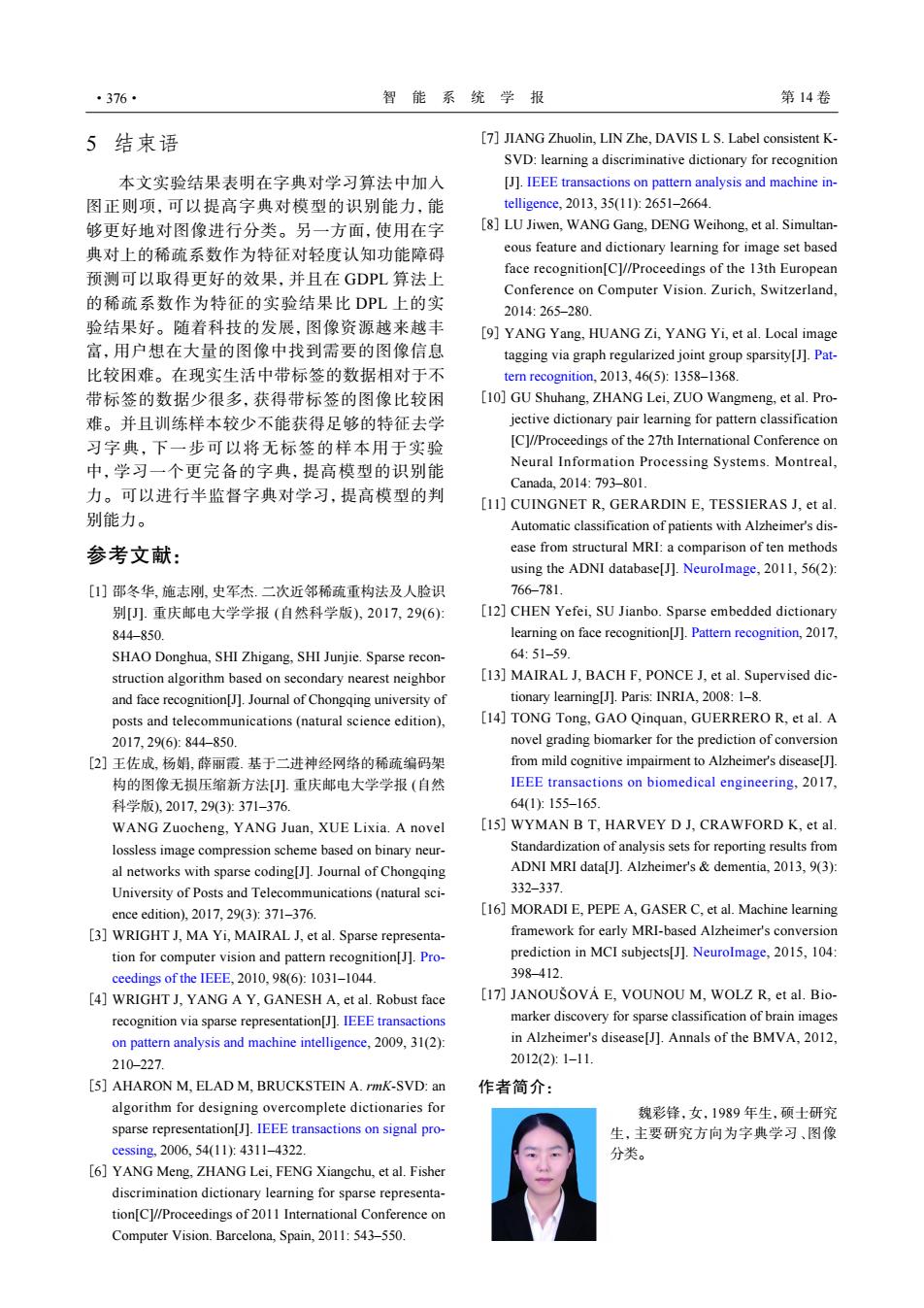正在加载图片...

·376· 智能系统学报 第14卷 5结束语 [7]JIANG Zhuolin,LIN Zhe,DAVIS L S.Label consistent K- SVD:learning a discriminative dictionary for recognition 本文实验结果表明在字典对学习算法中加入 [J].IEEE transactions on pattern analysis and machine in- 图正则项,可以提高字典对模型的识别能力,能 telligence.2013.35(11):2651-2664. 够更好地对图像进行分类。另一方面,使用在字 [8]LU Jiwen,WANG Gang,DENG Weihong,et al.Simultan- 典对上的稀疏系数作为特征对轻度认知功能障碍 eous feature and dictionary learning for image set based 预测可以取得更好的效果,并且在GDPL算法上 face recognition[C]//Proceedings of the 13th European Conference on Computer Vision.Zurich,Switzerland. 的稀疏系数作为特征的实验结果比DPL上的实 2014:265-280. 验结果好。随着科技的发展,图像资源越来越丰 [9]YANG Yang,HUANG Zi,YANG Yi,et al.Local image 富,用户想在大量的图像中找到需要的图像信息 tagging via graph regularized joint group sparsity[J].Pat- 比较困难。在现实生活中带标签的数据相对于不 tern recognition,2013,46(5):1358-1368. 带标签的数据少很多,获得带标签的图像比较困 [10]GU Shuhang,ZHANG Lei,ZUO Wangmeng,et al.Pro- 难。并且训练样本较少不能获得足够的特征去学 jective dictionary pair learning for pattern classification 习字典,下一步可以将无标签的样本用于实验 [C]//Proceedings of the 27th International Conference on 中,学习一个更完备的字典,提高模型的识别能 Neural Information Processing Systems.Montreal, Canada,2014:793-801. 力。可以进行半监督字典对学习,提高模型的判 [11]CUINGNET R.GERARDIN E.TESSIERAS J.et al. 别能力。 Automatic classification of patients with Alzheimer's dis- 参考文献: ease from structural MRI:a comparison of ten methods using the ADNI database[J].Neurolmage,2011,56(2): [1]邵冬华,施志刚.史军杰.二次近邻稀疏重构法及人脸识 766-781. 别[.重庆邮电大学学报(自然科学版),2017,29(6): [12]CHEN Yefei,SU Jianbo.Sparse embedded dictionary 844850 learning on face recognition[J].Pattern recognition,2017, SHAO Donghua,SHI Zhigang,SHI Junjie.Sparse recon- 64:51-59. struction algorithm based on secondary nearest neighbor [13]MAIRAL J,BACH F,PONCE J,et al.Supervised dic- and face recognition[J].Journal of Chongqing university of tionary learning[J].Paris:INRIA,2008:1-8. posts and telecommunications(natural science edition), [14]TONG Tong,GAO Qinquan,GUERRERO R,et al.A 2017,29(6):844-850. novel grading biomarker for the prediction of conversion [2]王佐成,杨娟,薛丽霞.基于二进神经网络的稀硫编码架 from mild cognitive impairment to Alzheimer's disease[J]. 构的图像无损压缩新方法).重庆邮电大学学报(自然 IEEE transactions on biomedical engineering,2017, 科学版),2017,293:371-376. 64(1:155-165. WANG Zuocheng,YANG Juan,XUE Lixia.A novel [15]WYMAN B T,HARVEY D J,CRAWFORD K,et al. lossless image compression scheme based on binary neur- Standardization of analysis sets for reporting results from al networks with sparse coding[J].Journal of Chongqing ADNI MRI data[J].Alzheimer's dementia,2013,9(3): University of Posts and Telecommunications (natural sci- 332-337. ence edition),2017,29(3):371-376. [16]MORADI E,PEPE A,GASER C,et al.Machine learning [3]WRIGHT J,MA Yi,MAIRAL J,et al.Sparse representa- framework for early MRI-based Alzheimer's conversion tion for computer vision and pattern recognition[J].Pro- prediction in MCI subjects[J].Neurolmage,2015,104: ceedings of the IEEE,2010,98(6):1031-1044. 398-412. [4]WRIGHT J,YANG A Y,GANESH A,et al.Robust face [17]JANOUSOVA E.VOUNOU M.WOLZ R.et al.Bio- recognition via sparse representation[J].IEEE transactions marker discovery for sparse classification of brain images on pattern analysis and machine intelligence,2009,31(2): in Alzheimer's disease[J].Annals of the BMVA,2012, 210-227. 2012(2):1-11 [5]AHARON M,ELAD M.BRUCKSTEIN A.rmK-SVD:an 作者简介: algorithm for designing overcomplete dictionaries for 魏彩锋,女,1989年生,硕士研究 sparse representation[J].IEEE transactions on signal pro- 生,主要研究方向为字典学习、图像 cessing,2006,54(11):4311-4322. 分类。 [6]YANG Meng,ZHANG Lei,FENG Xiangchu,et al.Fisher discrimination dictionary learning for sparse representa- tion[C]//Proceedings of 2011 International Conference on Computer Vision.Barcelona,Spain,2011:543-550.5 结束语 本文实验结果表明在字典对学习算法中加入 图正则项,可以提高字典对模型的识别能力,能 够更好地对图像进行分类。另一方面,使用在字 典对上的稀疏系数作为特征对轻度认知功能障碍 预测可以取得更好的效果,并且在 GDPL 算法上 的稀疏系数作为特征的实验结果比 DPL 上的实 验结果好。随着科技的发展,图像资源越来越丰 富,用户想在大量的图像中找到需要的图像信息 比较困难。在现实生活中带标签的数据相对于不 带标签的数据少很多,获得带标签的图像比较困 难。并且训练样本较少不能获得足够的特征去学 习字典,下一步可以将无标签的样本用于实验 中,学习一个更完备的字典,提高模型的识别能 力。可以进行半监督字典对学习,提高模型的判 别能力。 参考文献: 邵冬华, 施志刚, 史军杰. 二次近邻稀疏重构法及人脸识 别[J]. 重庆邮电大学学报 (自然科学版), 2017, 29(6): 844–850. SHAO Donghua, SHI Zhigang, SHI Junjie. Sparse reconstruction algorithm based on secondary nearest neighbor and face recognition[J]. Journal of Chongqing university of posts and telecommunications (natural science edition), 2017, 29(6): 844–850. [1] 王佐成, 杨娟, 薛丽霞. 基于二进神经网络的稀疏编码架 构的图像无损压缩新方法[J]. 重庆邮电大学学报 (自然 科学版), 2017, 29(3): 371–376. WANG Zuocheng, YANG Juan, XUE Lixia. A novel lossless image compression scheme based on binary neural networks with sparse coding[J]. Journal of Chongqing University of Posts and Telecommunications (natural science edition), 2017, 29(3): 371–376. [2] WRIGHT J, MA Yi, MAIRAL J, et al. Sparse representation for computer vision and pattern recognition[J]. Proceedings of the IEEE, 2010, 98(6): 1031–1044. [3] WRIGHT J, YANG A Y, GANESH A, et al. Robust face recognition via sparse representation[J]. IEEE transactions on pattern analysis and machine intelligence, 2009, 31(2): 210–227. [4] AHARON M, ELAD M, BRUCKSTEIN A. rmK-SVD: an algorithm for designing overcomplete dictionaries for sparse representation[J]. IEEE transactions on signal processing, 2006, 54(11): 4311–4322. [5] YANG Meng, ZHANG Lei, FENG Xiangchu, et al. Fisher discrimination dictionary learning for sparse representation[C]//Proceedings of 2011 International Conference on Computer Vision. Barcelona, Spain, 2011: 543–550. [6] JIANG Zhuolin, LIN Zhe, DAVIS L S. Label consistent KSVD: learning a discriminative dictionary for recognition [J]. IEEE transactions on pattern analysis and machine intelligence, 2013, 35(11): 2651–2664. [7] LU Jiwen, WANG Gang, DENG Weihong, et al. Simultaneous feature and dictionary learning for image set based face recognition[C]//Proceedings of the 13th European Conference on Computer Vision. Zurich, Switzerland, 2014: 265–280. [8] YANG Yang, HUANG Zi, YANG Yi, et al. Local image tagging via graph regularized joint group sparsity[J]. Pattern recognition, 2013, 46(5): 1358–1368. [9] GU Shuhang, ZHANG Lei, ZUO Wangmeng, et al. Projective dictionary pair learning for pattern classification [C]//Proceedings of the 27th International Conference on Neural Information Processing Systems. Montreal, Canada, 2014: 793–801. [10] CUINGNET R, GERARDIN E, TESSIERAS J, et al. Automatic classification of patients with Alzheimer's disease from structural MRI: a comparison of ten methods using the ADNI database[J]. NeuroImage, 2011, 56(2): 766–781. [11] CHEN Yefei, SU Jianbo. Sparse embedded dictionary learning on face recognition[J]. Pattern recognition, 2017, 64: 51–59. [12] MAIRAL J, BACH F, PONCE J, et al. Supervised dictionary learning[J]. Paris: INRIA, 2008: 1–8. [13] TONG Tong, GAO Qinquan, GUERRERO R, et al. A novel grading biomarker for the prediction of conversion from mild cognitive impairment to Alzheimer's disease[J]. IEEE transactions on biomedical engineering, 2017, 64(1): 155–165. [14] WYMAN B T, HARVEY D J, CRAWFORD K, et al. Standardization of analysis sets for reporting results from ADNI MRI data[J]. Alzheimer's & dementia, 2013, 9(3): 332–337. [15] MORADI E, PEPE A, GASER C, et al. Machine learning framework for early MRI-based Alzheimer's conversion prediction in MCI subjects[J]. NeuroImage, 2015, 104: 398–412. [16] JANOUŠOVÁ E, VOUNOU M, WOLZ R, et al. Biomarker discovery for sparse classification of brain images in Alzheimer's disease[J]. Annals of the BMVA, 2012, 2012(2): 1–11. [17] 作者简介: 魏彩锋,女,1989 年生,硕士研究 生,主要研究方向为字典学习、图像 分类。 ·376· 智 能 系 统 学 报 第 14 卷